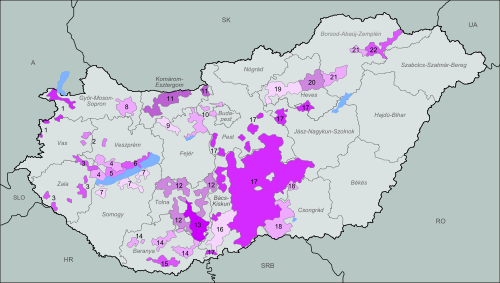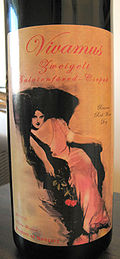- Hungarian wine
-
 The 22 wine regions of Hungary: 1 Sopron, 2 Nagy-Somló, 3 Zala, 4 Balatonfelvidék, 5 Badacsony, 6 Balatonfüred-Csopak, 7 Balatonboglár, 8 Pannonhalma, 9 Mór, 10 Etyek-Buda, 11 Ászár-Neszmély, 12 Tolna, 13 Szekszárd, 14 Pécs, 15 Villány, 16 Hajós-Baja, 17 Kunság, 18 Csongrád, 19 Mátra, 20 Eger, 21 Bükk, 22 Tokaj-Hegyalja
The 22 wine regions of Hungary: 1 Sopron, 2 Nagy-Somló, 3 Zala, 4 Balatonfelvidék, 5 Badacsony, 6 Balatonfüred-Csopak, 7 Balatonboglár, 8 Pannonhalma, 9 Mór, 10 Etyek-Buda, 11 Ászár-Neszmély, 12 Tolna, 13 Szekszárd, 14 Pécs, 15 Villány, 16 Hajós-Baja, 17 Kunság, 18 Csongrád, 19 Mátra, 20 Eger, 21 Bükk, 22 Tokaj-Hegyalja
Hungarian wine has a history dating back to at least Roman times. Outside of Hungary, the best-known wines are the white dessert wine Tokaji and the red wine Bull's Blood of Eger (Egri Bikavér).
Contents
History
Only two European languages have words for wine that are not derived from Latin: Greek and Hungarian.[1] Records carved in a Runic alphabet used by ancient Hungarians have words for wine derived from Turkic. Two hundred Hungarian words (wine as well) that are of Bulgar-Turkic origin,[1] suggesting that the Magyars had contact with the first winemakers in the South Caucasus. Examples include :
- Szőlő: "grape"
- Bor: "wine"
- Ászok: "cask"
- Áldomás: "blessing", "libation"
The Romans brought vines to Pannonia, and by the 5th century AD, there are records of extensive vineyards in Hungary. Following the Magyar invasion of 896, Árpád rewarded his followers with vineyards in Tokaj[citation needed]. Over the following centuries, new grape varieties were brought in from Italy and France. Most of the production was of white wine.
During the invasion of Suleiman the Magnificent in the early 16th century, displaced Serbs brought the red Kadarka grape to Eger. This ancient variety was used to make the robust red wine blend later known as Bull's Blood, after the supposed secret ingredient in the wine that fortified the defenders of Eger in 1552.
It was also during the Turkish occupation that the Tokaj region became known for dessert wines, harvested late to encourage noble rot. Tokaji aszú is mentioned in a document of 1571, and it was famously christened by Louis XIV of France (1638-1715) "Vinum Regum, Rex Vinorum" - Wine of Kings, King of Wines.
After the Ottoman Empire ceded Hungary to the Austrians in 1699, the Germanic influence was felt with the introduction of grape varieties such as Blauer Portugieser. That influence also showed[citation needed] in the start in 1730 of the world's first vineyard classification in Tokaj, based on soil, aspect and propensity to noble rot.
From 1882, the phylloxera epidemic hit Hungary hard, with the traditional field blends of Eger and the many grapes of Tokaj being replaced with monocultures, often of Blaufränkisch (Kékfrankos) and the Bordeaux varieties in red wine districts, and of Furmint, Muscat and Hárslevelű in Tokaj. The twentieth century saw the introduction of modern grapes such as Zweigelt, which were easier to grow and to vinify than Kadarka, and under Communism quality was neglected in favour of overcropping, pasteurisation, and industrial production. Since 1989, there has been renewed interest in the traditional varieties and a lot of new investment, particularly in Tokaj-Hegyalja.
Wine regions and styles
Észak-Dunántúl (North Transdanubia)
This wine region contains the following sub-regions:
Ászár-Neszmély: fresh and aromatic whites.
Etyek-Buda: fresh white wines, with considerable acidity.
Mór: volcanic soil, full-bodied whites. Main variety: Ezerjó.
Pannonhalma: full-bodied whites.
Sopron: elegant reds (mainly Kékfrankos).Balaton
Sub-regions:
Badacsony: volcanic soils, full-bodied whites with considerable acidity.
Balatonfelvidék: volcanic soils, full-bodied whites with considerable acidity.
Balatonfüred-Csopak: terra rossa soils, full-bodied whites with considerable acidity.
Dél-Balaton: full-bodied whites and reds with moderate acidity.
Nagy-Somló (or Somló): volcanic soil, full-bodied whites with high acidity. Main varieties are: Olaszrizling, Hárslevelű and Furmint.
Zala: mainly white wines.
The main variety of the region is Olaszrizling.Dél-Pannónia (South Pannonia)
Sub-regions:
Pécs: mainly whites. Traditional variety: Cirfandli
Villány: robust, full-bodied, spicy reds. Main varieties: Blauer Portugieser, Cabernet Sauvignon, Cabernet Franc, Merlot and occasionally Pinot Noir.
Szekszárd: full-bodied reds, with a bit of spice. Famous wine: Szekszárdi Bikavér. Main varieties: Kadarka, Kékfrankos, Cabernet franc, Merlot
TolnaDuna (Alföld)
Sub-regions:
Csongrád,
Hajós-Baja,
Kunság.
Mainly fresh and light wines from lots of varieties.Felső-Magyarország (Upper Hungary)
Sub-regions:
Eger: fresh whites from Leányka and Királyleányka, full-bodied whites mainly from Olaszrizling or Chardonnay. Home of the Egri Bikavér (bulls blood of Eger), an elegant red blend, mainly based on Kékfrankos. Good Pinot noirs.
Mátra: elegant and full-bodied whites, grown on volcanic soil. Main varieties are Müller-Thurgau, Olaszrizling and Chardonnay.
Bükkalja: mainly white wines.Tokaj
Hungary's most famous wine region lies in the foothills of the Zemplén Mountains of the far north of the country - in fact the traditional area crosses into the southeast corner of modern Slovakia. The area is notable for its long warm autumns and mists that come in from the River Bodrog, creating perfect conditions for noble rot. This can contribute towards creating the botrytised ('aszú') grapes for which the region is famous. These are individually picked as late as mid-November into buckets ('puttonyos') and crushed to a paste. Varying amounts of this aszú paste are then added to non-aszú must or wine made from a mix of Furmint, Hárslevelű, Muscat Blanc à Petits Grains, Kövérszőlő or Zéta grapes, and left to ferment. The resulting wine is then aged in relatively small barrels in a labyrinth of cellars in the soft volcanic tuff, on whose walls thick blankets of fungus regulate the humidity.[2]
Given that aszú conditions only happen in perhaps three vintages per decade, a lot of dry Furmint is also produced. Other grapes grown in the area include Hárslevelű, Muscat Blanc, Kövérszőlő and Zéta.
Hungarian grape varieties
Several varieties of grape are known to have originated in Hungary. These are:
- Ezerjó
- Hárslevelű
- Irsai Oliver
- Cserszegi Fűszeres
- Királyleányka
Other varieties of grape that may have originated in Hungary include:
See also
References
- ^ a b Miklós Molnár, A concise history of Hungary, Cambridge University Press, 2001, p. 12
- ^ Atkin, Tim (2001) Tradition and Innovation in the Tokaj Region Dissertation for Master of Wine
External links
- Hungarian Wines - Hungarian wine regions and Decanter awards
- The Royal Tokaji Wine Company
- The Hungarian Wine Society - the latest developments in Hungarian winemaking
- Archimedia.hu - good overview of the regions and wines
- Wine Reviews - Independent wine blog
Wines General Wine styles Grape varieties International
varietiesWhiteRedRegional
varietiesWine-producing countries (regions) - New South Wales
- South Australia
- Tasmania
- Victoria
- Western Australia
OtherWine by country Albania · Algeria · Argentina · Armenia · Australia · Austria · Azerbaijan · Belgium · Brazil · Bulgaria · Canada · Chile · China · Croatia · Cyprus · Czech Republic · Denmark · Egypt · France · Germany · Georgia · Greece · Hungary · India · Iran · Israel · Italy · Japan · Kazakhstan · Lebanon · Liechtenstein · Luxembourg · Macedonia · Malta · Mexico · Moldova · Montenegro · Morocco · Namibia · Netherlands · New Zealand · Portugal · Romania · Russia · San Marino · Serbia · Slovakia · Slovenia · South Africa · Spain · Sweden · Switzerland · Turkey · Ukraine · United Kingdom · United States · Uruguay · Vietnam Categories:
Categories:
Wikimedia Foundation. 2010.





